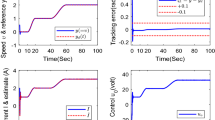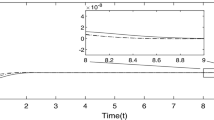Abstract
This paper proposes a novel adaptive observer technique for estimating the state and disturbance of uncertain nonlinear systems. To remove the knowledge of the upper bounds of the disturbance and its derivative, a leakage-type (LT) algorithm is introduced to approximate the variations of their bounds. A state observer is first provided based on a conventional Walcott–Zak observer structure, and then, a disturbance observer is proposed by introducing an auxiliary dynamics. Due to the features of the LT adaptive law, the estimation error of the system state or the disturbance is bounded in a small neighborhood around zero in finite time. In addition, since the switching gain is automatically adapted to the disturbance change, the chattering in the estimation signal is effectively suppressed that is useful for the estimation precision in a practical system. Another important advantage of the proposed method lies in its simple structure compared to the existing finite-time observers. Lyapunov analysis demonstrates that for both types of observers, the estimation error is achieved to be globally uniformly ultimately bounded. To demonstrate the proposed method, simulation examples are separately carried out on a vehicle system and a linear motor system.








Similar content being viewed by others
Data Availibility
Data sharing is not applicable to this article as no datasets were generated or analyzed during the current study.
References
Aaron Radke and Zhiqiang Gao A survey of state and disturbance observers for practitioners. American Control Conference, 2006
Hou, Q., Ding, S.: GPIO based super-twisting sliding mode control for PMSM. IEEE Trans. Circ. Syst. II Express Briefs 68(2), 747–751 (2021)
Antonov, S., Fehn, A., Kugi, A.: Unscented kalman filter for vehicle state estimation. Vehicle Syst. Dynam. 49(9), 1497–1520 (2011)
Ning, W.H., Wang, W.J.: Observer design and output feedback stabilization for nonlinear multivariable systems with diffusion PDE-governed sensor dynamics. Nonlinear Dynam. 72(3), 615–628 (2013)
Rsetam, K., Cao, Z., Man, Z.: Cascaded-extended-state-observer-based sliding-mode control for underactuated flexible joint robot. Trans. Indus. Electron. 67(12), 10822–10832 (2020)
Madoski, R., Stankovic, M.R., Shao, S.S., Gao, Z., Li, S.: Active disturbance rejection control of torsional plant with unknown frequency harmonic disturbance. Control Eng. Practice 100, 104413 (2020)
Hou, Q., Ding, S., Xinghuo, Y.: Composite super-twisting sliding mode control design for PMSM speed regulation problem based on a novel disturbance observer. IEEE Trans. Energy Conv. (2020). https://doi.org/10.1109/TEC.2020.2985054
Li, S., Sun, H., Yang, J., Xinghuo, Y.: Continuous finite-time output regulation for disturbed systems under mismatching condition. IEEE Trans. Automatic Control 60(1), 277–282 (2015)
Shao, K., Zheng, J., Wang, H., Feng, X., Liang, B.: Recursive sliding mode control with adaptive disturbance observer for a linear motor positioner. Mech. Syst. Signal Process. 146, 107014 (2021)
Ding, S., Chen, W.-H., Mei, K., Murray-Smith, D.J.: Disturbance observer design for nonlinear systems represented by input-output models. IEEE Trans. Indus. Electron. 67(2), 1222–1232 (2020)
Bandyopadhyay, B., Gandhi, P., Kurode, S.: Sliding mode observer based sliding mode controller for slosh-free motion through PID scheme. IEEE Trans. Indus. Electron. 56(9), 3432–3442 (2009)
Lin, S., Cai, Y., Yang, B., Zhang, W.: Electrical line-shafting control for motor speed synchronisation using sliding mode controller and disturbance observer. IET Control Theory Appl. 11(2), 205–212 (2016)
Ji Xiang, Hongye Su, and Jian Chu. On the design of Walcott-Zak sliding mode observer. American Control Conference, 2451–2456 2005
Edwards, Christopher, Spurgeon, Sarah K.: Sliding Mode Control: Theory and Applications. CRC Press, Cambridge (1998)
Kalsi, Karanjit, Lian, Jianming, Hui, Stefen, Żak, Stanislaw H.: Sliding-mode observers for systems with unknown inputs: a high-gain approach. Automatica 46, 347–353 (2010)
Xiaobo, L., Yao, Y., Chang, Y.S.: A decoupling control for quadrotor UAV using dynamic surface control and sliding mode disturbance observer. Nonlinear Dynam. 97(1), 781–795 (2019)
Wang, N., Sun, Z., Yin, J., Zou, Z., Shun-Feng, S.: Fuzzy unknown observer-based robust adaptive path following control of underactuated surface vehicles subject to multiple unknowns. Ocean Eng. 176, 57–64 (2019)
Yingchun, W., Longfei, Z., Huaguang, Z., Wei, X.Z.: Fuzzy observer-based repetitive tracking control for nonlinear systems. IEEE Trans. Fuzzy Sys. 28(10), 2401–2415 (2020)
Feng, Y., Xinghuo, Y., Han, F.: On nonsingular terminal sliding-mode control of nonlinear systems. Automatica 49, 1715–1722 (2013)
Prasad, S., Ansari, M.R.: Frequency regulation using neural network observer based controller in power system. Control Eng. Practice 102, 104571 (2020)
Petros Ioannou and Simone Baldi. Robust Adaptive Control. IEEE, 1984
Shao, K., Zheng, J., Wang, H., Wang, X., Lu, R., Man, Z.: Tracking control of a linear motor positioner based on barrier function adaptive sliding mode. IEEE Trans. Indus. Inform. (2021). https://doi.org/10.1109/TII.2021.3057832
Shao, K.: Nested adaptive integral terminal sliding mode control for high-order uncertain nonlinear systems. Int. J. Robust Nonlinear Control (2021). https://doi.org/10.1002/rnc.5631
Shtessel, Yuri B., Shkolnikov, Ilya A., Levant, Arie: Smooth second-order sliding modes: missile guidance application. Automatica 43(8), 1470–1476 (2007)
Yang, J., Li, S., Jinya, S., Xinghuo, Y.: Continuous nonsingular terminal sliding mode control for systems with mismatched disturbances. Automatica 49(7), 2287–2291 (2013)
Wang, H., Shi, L., Man, Z., Zheng, J., Li, S., Ming, Y., Jiang, C., Kong, H., Cao, Z.: Continuous fast nonsingular terminal sliding mode control of automotive electronic throttle systems using finite-time exact observer. IEEE Trans. Indus. Electron. 65(9), 7160–7172 (2018)
Rabiee, H., Ataei, M., Ekramian, M.: Continuous nonsingular terminal sliding mode control based on adaptive sliding mode disturbance observer for uncertain nonlinear systems. Automatica 109, 108515 (2019)
Sun, H., Chen, Y.-H., Zhao, H.: Adaptive robust control methodology for active roll control system with uncertainty. Nonlinear Dynam. 92(2), 359–371 (2018)
Li, P., Xiang, Y., Xiao, B.: Adaptive quasi-optimal higher order sliding-mode control without gain overestimation. IEEE Trans. Indus. Inform. 14(9), 3881–3891 (2018)
Zhang, J., Shi, P., Xia, Y.: Robust adaptive sliding-mode control for fuzzy systems with mismatched uncertainties. IEEE Trans. Fuzzy Syst. 18(4), 700–711 (2010)
Roy, S., Baldi, S., Fridman, L.M.: On adaptive sliding mode control without a priori bounded uncertainty. Automatica 111, 108650 (2019)
H.K. Khalil. Nonlinear Systems (3rd ed.). Prentice hall Upper Saddle River, 2002
Rodrigues, V.H.P., Oliveira, T.R.: Global adaptive HOSM differentiators via monitoring functions and hybrid state-norm observers for output feedback. Int. J. Control 91(9), 2060–2072 (2018)
Rios, H., Efimov, D., Perruquetti, W.: An adaptive sliding-mode observer for a class of uncertain nonlinear systems. Int. J. Adaptive Control Signal Process. 32(3), 511–527 (2018)
Shtessel, Y., Edwards, C., Fridman, L., Levant, A.: Sliding Mode Control and Observation. Springer, New York (2014)
Shen, Q., Jiang, B., Cocquempot, V.: Adaptive fuzzy observer-based active fault-tolerant dynamic surface control for a class of nonlinear systems with actuator faults. IEEE Trans. Fuzzy Syst. 22(2), 338–349 (2014)
Rajamani, R.: Vehicle Dynamics and Control. Springer, New York (2011)
Shao, K., Zheng, J., Huang, K., Wang, H., Minyue, F.: Finite-time control of a linear motor positioner using adaptive recursive terminal sliding mode. IEEE Trans. Indus. Electron. 67(8), 6659–6668 (2020)
Gieras, J.F., Piech, Z.J., Tomczuk, B.: Linear Synchronous Motors: Transportation and Automation Systems. CRC Press, Cambridge (2016)
Wojtyra, Marek: multibody simulation model of human walking. Mech. Based Design Struct. Mach. 31(3), 357–379 (2003)
Youhao, H., Wang, H.: Robust tracking control for vehicle electronic throttle using adaptive dynamic sliding mode and extended state observer. Mech Syst Signal Process 135, 106375 (2020)
Acknowledgements
This work was supported by the National Natural Science Foundation of China (No. U1813216 and No. 62003186) and the Natural Science Foundation of Guangdong Province (No. 2020A1515010334).
Author information
Authors and Affiliations
Corresponding author
Ethics declarations
Conflict of interest
The authors declare that they have no conflict of interest.
Additional information
Publisher's Note
Springer Nature remains neutral with regard to jurisdictional claims in published maps and institutional affiliations.
Appendix
Appendix
1.1 A Proof of Lemma 2.3
Inequality (3) can be rewritten as
where \(0<\theta <1\). It is obvious that if \(V(x)>\frac{\epsilon }{\kappa (1-\theta )}\), \(\dot{V}(x)\le -\kappa \theta V(x)\). Therefore, V(x) is bounded by
Furthermore, for \(\dot{V}(x)\le -\kappa \theta V(x)\), we obtain
Let \(t_V\) be the time required to reach the region \(V(x)=\bar{b}\). Integrating (50) between V(x) and \(\bar{b}\) leads to
Therefore,
This completes the proof.
Rights and permissions
About this article
Cite this article
Shao, K., Zheng, J., Wang, H. et al. Leakage-type adaptive state and disturbance observers for uncertain nonlinear systems. Nonlinear Dyn 105, 2299–2311 (2021). https://doi.org/10.1007/s11071-021-06715-6
Received:
Accepted:
Published:
Issue Date:
DOI: https://doi.org/10.1007/s11071-021-06715-6




